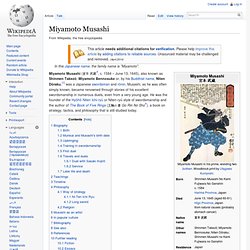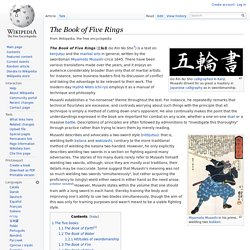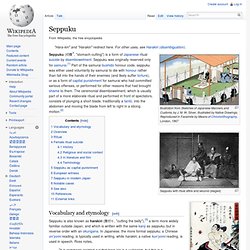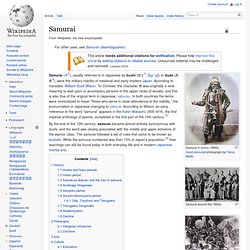

Miyamoto Musashi. Miyamoto Musashi (宮本 武蔵?

, c. 1584 – June 13, 1645), also known as Shinmen Takezō, Miyamoto Bennosuke or, by his Buddhist name, Niten Dōraku,[1] was a Japanese swordsman and rōnin. Musashi, as he was often simply known, became renowned through stories of his excellent swordsmanship in numerous duels, even from a very young age. He was the founder of the Hyōhō Niten Ichi-ryū or Niten-ryū style of swordsmanship and the author of The Book of Five Rings (五輪の書, Go Rin No Sho?)
, a book on strategy, tactics, and philosophy that is still studied today. Biography[edit] Birth[edit] The details of Miyamoto Musashi's early life are difficult to verify. Munisai and Musashi's birth date[edit] Munisai's tomb says he died in 1580, which obviously conflicts with the accepted birth date of 1584 for Musashi. Because of the uncertainty centering on Munisai (when he died, whether he was truly Musashi's father, etc.), Musashi's mother is known with even less confidence. Munisai's tomb was correct. The Book of Five Rings. The Book of Five Rings (五輪書, Go Rin No Sho?)

Is a text on kenjutsu and the martial arts in general, written by the swordsman Miyamoto Musashi circa 1645. There have been various translations made over the years, and it enjoys an audience considerably broader than only that of martial artists: for instance, some business leaders find its discussion of conflict and taking the advantage to be relevant to their work. The modern-day Hyōhō Niten Ichi-ryū employs it as a manual of technique and philosophy. Musashi establishes a "no-nonsense" theme throughout the text. For instance, he repeatedly remarks that technical flourishes are excessive, and contrasts worrying about such things with the principle that all technique is simply a method of cutting down one's opponent. Musashi describes and advocates a two-sword style (nitōjutsu): that is, wielding both katana and wakizashi, contrary to the more traditional method of wielding the katana two-handed.
The five books[edit] Shrike on a Dead Branch. Bushido. Japanese samurai in armour, 1860s.

Photograph by Felice Beato Bushidō (武士道?) , literally "samurai's way", is a Japanese word for the way of the samurai life, loosely analogous to the concept of chivalry. Bushido, a modern term rather than a historical one, originates from the samurai moral values, most commonly stressing some combination of frugality, loyalty, martial arts mastery, and honor unto death. Born from Neo-Confucianism during times of peace in Tokugawa Japan and following Confucian texts, Bushido was also influenced by Shinto and Zen Buddhism, allowing the violent existence of the samurai to be tempered by wisdom and serenity. Under the Tokugawa Shogunate, some aspects of warrior values became formalized into Japanese feudal law.[2] The word was first used in Japan during the 17th century.[3] It came into common usage in Japan and the West after the 1899 publication of Nitobe Inazō's Bushido: The Soul of Japan.[4] In Bushido (1899), Nitobe wrote: Historical development[edit] Seppuku. Illustration from Sketches of Japanese Manners and Customs, by J.

M. W. Silver, Illustrated by Native Drawings, Reproduced in Facsimile by Means of Chromolithography, London, 1867 Seppuku with ritual attire and second (staged) Samurai about to perform seppuku Seppuku (切腹? Vocabulary and etymology[edit] Seppuku is also known as harakiri (腹切り, "cutting the belly"),[3] a term more widely familiar outside Japan, and which is written with the same kanji as seppuku, but in reverse order with an okurigana. "It is commonly pointed out that hara-kiri is a vulgarism, but this is a misunderstanding. The practice of committing seppuku at the death of one's master, known as oibara (追腹 or 追い腹, the kun'yomi or Japanese reading) or tsuifuku (追腹, the on'yomi or Chinese reading), follows a similar ritual. The Samurai - Part 1 of 10.
Mark Dacascos...and the legend of Samurai warrior Miyamoto Musashi (documentary) Samurai. Samurai around the 1860s Samurai (侍?)

, usually referred to in Japanese as bushi (武士? , [bu͍ꜜ.ɕi̥]) or buke (武家?) , were the military nobility of medieval and early-modern Japan. According to translator William Scott Wilson: "In Chinese, the character 侍 was originally a verb meaning to wait upon or accompany persons in the upper ranks of society, and this is also true of the original term in Japanese, saburau.
By the end of the 12th century, samurai became almost entirely synonymous with bushi, and the word was closely associated with the middle and upper echelons of the warrior class. History Asuka and Nara periods Following the Battle of Hakusukinoe against Tang China and Silla in 663 AD that led to a Japanese retreat from Korean affairs, Japan underwent widespread reform. The Taihō Code classified most of the Imperial bureaucrats into 12 ranks, each divided into two sub-ranks, 1st rank being the highest adviser to the Emperor. Heian period Ultimately, Emperor Kammu disbanded his army.